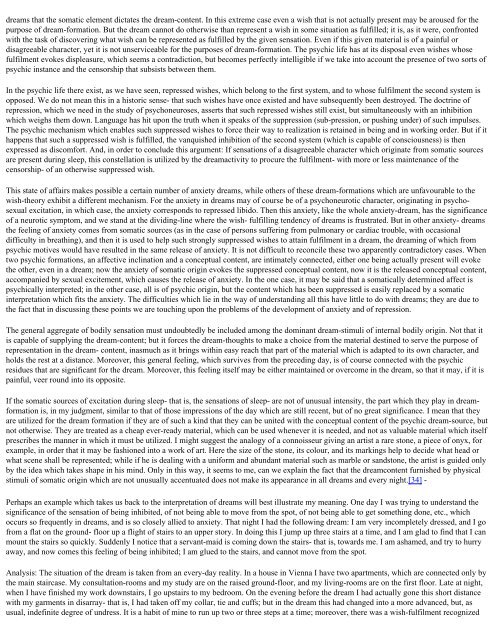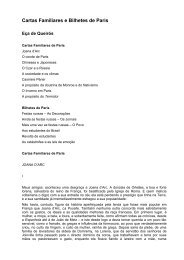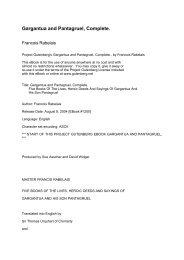The Interpretation of Dreams Sigmund Freud (1900)
The Interpretation of Dreams Sigmund Freud (1900)
The Interpretation of Dreams Sigmund Freud (1900)
You also want an ePaper? Increase the reach of your titles
YUMPU automatically turns print PDFs into web optimized ePapers that Google loves.
dreams that the somatic element dictates the dream-content. In this extreme case even a wish that is not actually present may be aroused for the<br />
purpose <strong>of</strong> dream-formation. But the dream cannot do otherwise than represent a wish in some situation as fulfilled; it is, as it were, confronted<br />
with the task <strong>of</strong> discovering what wish can be represented as fulfilled by the given sensation. Even if this given material is <strong>of</strong> a painful or<br />
disagreeable character, yet it is not unserviceable for the purposes <strong>of</strong> dream-formation. <strong>The</strong> psychic life has at its disposal even wishes whose<br />
fulfilment evokes displeasure, which seems a contradiction, but becomes perfectly intelligible if we take into account the presence <strong>of</strong> two sorts <strong>of</strong><br />
psychic instance and the censorship that subsists between them.<br />
In the psychic life there exist, as we have seen, repressed wishes, which belong to the first system, and to whose fulfilment the second system is<br />
opposed. We do not mean this in a historic sense- that such wishes have once existed and have subsequently been destroyed. <strong>The</strong> doctrine <strong>of</strong><br />
repression, which we need in the study <strong>of</strong> psychoneuroses, asserts that such repressed wishes still exist, but simultaneously with an inhibition<br />
which weighs them down. Language has hit upon the truth when it speaks <strong>of</strong> the suppression (sub-pression, or pushing under) <strong>of</strong> such impulses.<br />
<strong>The</strong> psychic mechanism which enables such suppressed wishes to force their way to realization is retained in being and in working order. But if it<br />
happens that such a suppressed wish is fulfilled, the vanquished inhibition <strong>of</strong> the second system (which is capable <strong>of</strong> consciousness) is then<br />
expressed as discomfort. And, in order to conclude this argument: If sensations <strong>of</strong> a disagreeable character which originate from somatic sources<br />
are present during sleep, this constellation is utilized by the dreamactivity to procure the fulfilment- with more or less maintenance <strong>of</strong> the<br />
censorship- <strong>of</strong> an otherwise suppressed wish.<br />
This state <strong>of</strong> affairs makes possible a certain number <strong>of</strong> anxiety dreams, while others <strong>of</strong> these dream-formations which are unfavourable to the<br />
wish-theory exhibit a different mechanism. For the anxiety in dreams may <strong>of</strong> course be <strong>of</strong> a psychoneurotic character, originating in psychosexual<br />
excitation, in which case, the anxiety corresponds to repressed libido. <strong>The</strong>n this anxiety, like the whole anxiety-dream, has the significance<br />
<strong>of</strong> a neurotic symptom, and we stand at the dividing-line where the wish- fulfilling tendency <strong>of</strong> dreams is frustrated. But in other anxiety- dreams<br />
the feeling <strong>of</strong> anxiety comes from somatic sources (as in the case <strong>of</strong> persons suffering from pulmonary or cardiac trouble, with occasional<br />
difficulty in breathing), and then it is used to help such strongly suppressed wishes to attain fulfilment in a dream, the dreaming <strong>of</strong> which from<br />
psychic motives would have resulted in the same release <strong>of</strong> anxiety. It is not difficult to reconcile these two apparently contradictory cases. When<br />
two psychic formations, an affective inclination and a conceptual content, are intimately connected, either one being actually present will evoke<br />
the other, even in a dream; now the anxiety <strong>of</strong> somatic origin evokes the suppressed conceptual content, now it is the released conceptual content,<br />
accompanied by sexual excitement, which causes the release <strong>of</strong> anxiety. In the one case, it may be said that a somatically determined affect is<br />
psychically interpreted; in the other case, all is <strong>of</strong> psychic origin, but the content which has been suppressed is easily replaced by a somatic<br />
interpretation which fits the anxiety. <strong>The</strong> difficulties which lie in the way <strong>of</strong> understanding all this have little to do with dreams; they are due to<br />
the fact that in discussing these points we are touching upon the problems <strong>of</strong> the development <strong>of</strong> anxiety and <strong>of</strong> repression.<br />
<strong>The</strong> general aggregate <strong>of</strong> bodily sensation must undoubtedly be included among the dominant dream-stimuli <strong>of</strong> internal bodily origin. Not that it<br />
is capable <strong>of</strong> supplying the dream-content; but it forces the dream-thoughts to make a choice from the material destined to serve the purpose <strong>of</strong><br />
representation in the dream- content, inasmuch as it brings within easy reach that part <strong>of</strong> the material which is adapted to its own character, and<br />
holds the rest at a distance. Moreover, this general feeling, which survives from the preceding day, is <strong>of</strong> course connected with the psychic<br />
residues that are significant for the dream. Moreover, this feeling itself may be either maintained or overcome in the dream, so that it may, if it is<br />
painful, veer round into its opposite.<br />
If the somatic sources <strong>of</strong> excitation during sleep- that is, the sensations <strong>of</strong> sleep- are not <strong>of</strong> unusual intensity, the part which they play in dreamformation<br />
is, in my judgment, similar to that <strong>of</strong> those impressions <strong>of</strong> the day which are still recent, but <strong>of</strong> no great significance. I mean that they<br />
are utilized for the dream formation if they are <strong>of</strong> such a kind that they can be united with the conceptual content <strong>of</strong> the psychic dream-source, but<br />
not otherwise. <strong>The</strong>y are treated as a cheap ever-ready material, which can be used whenever it is needed, and not as valuable material which itself<br />
prescribes the manner in which it must be utilized. I might suggest the analogy <strong>of</strong> a connoisseur giving an artist a rare stone, a piece <strong>of</strong> onyx, for<br />
example, in order that it may be fashioned into a work <strong>of</strong> art. Here the size <strong>of</strong> the stone, its colour, and its markings help to decide what head or<br />
what scene shall be represented; while if he is dealing with a uniform and abundant material such as marble or sandstone, the artist is guided only<br />
by the idea which takes shape in his mind. Only in this way, it seems to me, can we explain the fact that the dreamcontent furnished by physical<br />
stimuli <strong>of</strong> somatic origin which are not unusually accentuated does not make its appearance in all dreams and every night.[34] -<br />
Perhaps an example which takes us back to the interpretation <strong>of</strong> dreams will best illustrate my meaning. One day I was trying to understand the<br />
significance <strong>of</strong> the sensation <strong>of</strong> being inhibited, <strong>of</strong> not being able to move from the spot, <strong>of</strong> not being able to get something done, etc., which<br />
occurs so frequently in dreams, and is so closely allied to anxiety. That night I had the following dream: I am very incompletely dressed, and I go<br />
from a flat on the ground- floor up a flight <strong>of</strong> stairs to an upper story. In doing this I jump up three stairs at a time, and I am glad to find that I can<br />
mount the stairs so quickly. Suddenly I notice that a servant-maid is coming down the stairs- that is, towards me. I am ashamed, and try to hurry<br />
away, and now comes this feeling <strong>of</strong> being inhibited; I am glued to the stairs, and cannot move from the spot.<br />
Analysis: <strong>The</strong> situation <strong>of</strong> the dream is taken from an every-day reality. In a house in Vienna I have two apartments, which are connected only by<br />
the main staircase. My consultation-rooms and my study are on the raised ground-floor, and my living-rooms are on the first floor. Late at night,<br />
when I have finished my work downstairs, I go upstairs to my bedroom. On the evening before the dream I had actually gone this short distance<br />
with my garments in disarray- that is, I had taken <strong>of</strong>f my collar, tie and cuffs; but in the dream this had changed into a more advanced, but, as<br />
usual, indefinite degree <strong>of</strong> undress. It is a habit <strong>of</strong> mine to run up two or three steps at a time; moreover, there was a wish-fulfilment recognized









